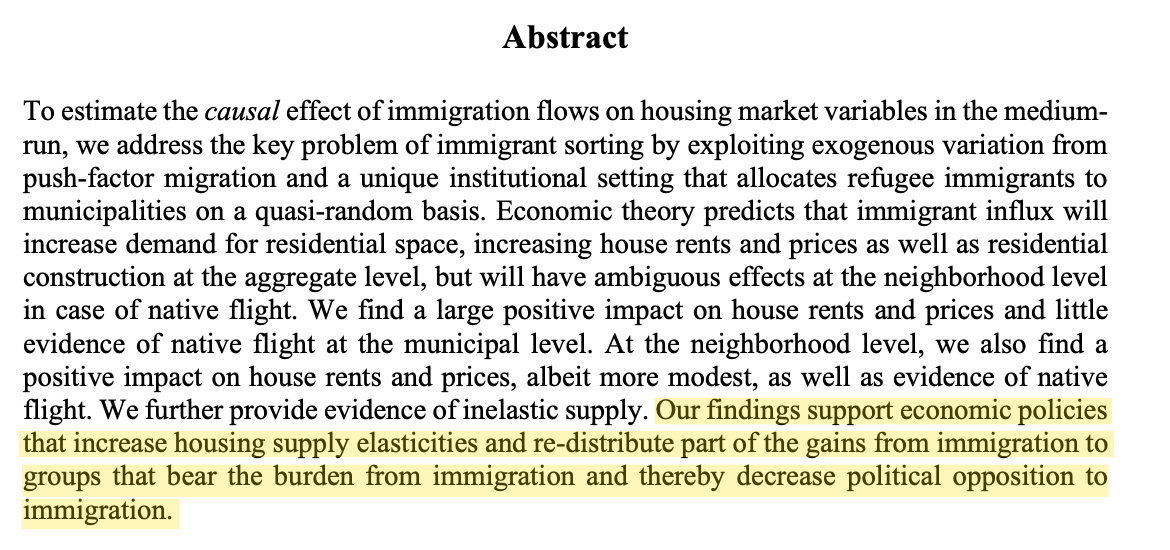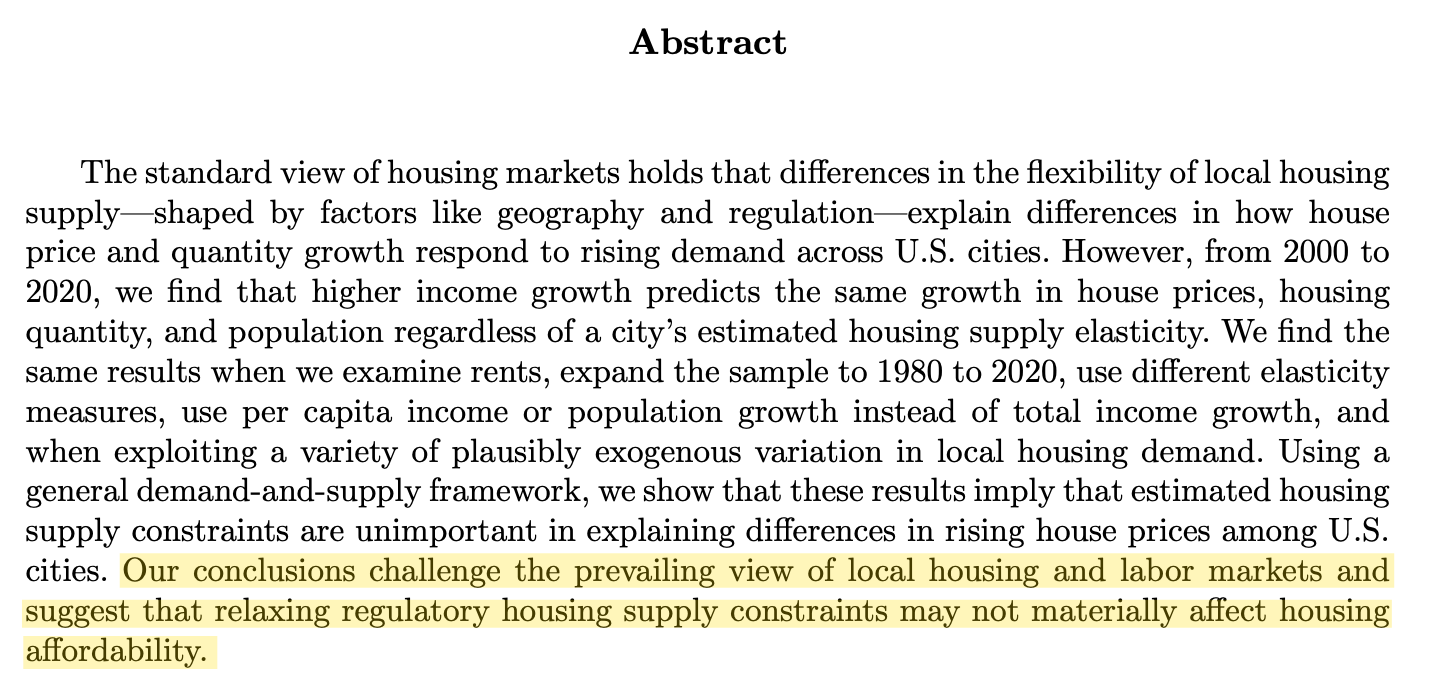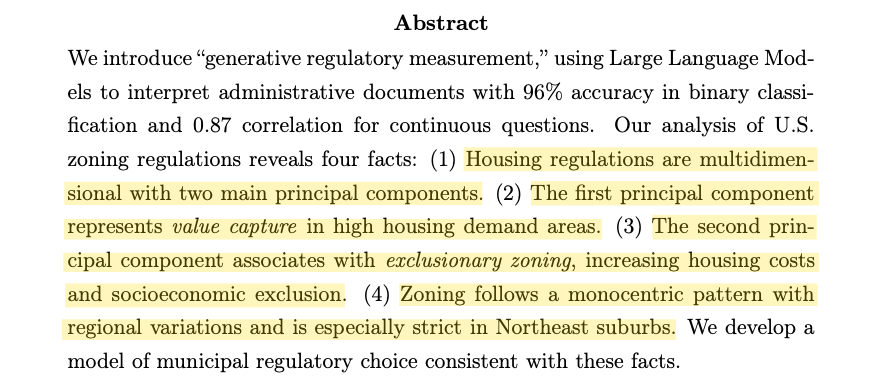Weekly Roundup #5
Housing | Week of 10.12 - 10.18
EXECUTIVE SUMMARY
Welcome back to Boyd’s weekly roundup series. Before digging in, we’re excited to announce that over the next few weeks we’ll be having conversations — mostly via Substack Live — with various housing market experts, policy wonks, and academicians. Be on the lookout for details by following the accounts of
and , as well as (obviously) account.This week’s roundup includes:
Newsflow on:
Investors taking a bigger bite of single-family homes;
Listings ticking up while rate-sensitive buyers sit out;
Foreclosures filings building up; and
California’s SB 79 transit-oriented development (TOD) upzoning bill signed into law.
Academic research on:
Immigration-driven demand lifting rents and prices without native displacement;
A sharp empirical challenge to the “it’s all supply constraints” orthodoxy; and
An LLM-rendered quantification of zoning that reveals which regulatory frameworks actually bite.
Additional reading on:
Hyperlocal veto power at public meetings;
A pragmatic state-level reform menu (TOD mandates, third-party plan review, fixing “illegal by right,” trimming aesthetic bans); and
A bold HUD preemption lever to unlock affordable supply.
If you haven’t already, do check out this week’s articles on where (and perhaps why) apartment rents are collapsing in the US, as well as whether immigration raises housing prices. Additionally, tune in to the Substack Live session tomorrow (10/12) where Peter and Will are going be discussing all of the below as well as engaging with comments/Q&A. Now, the roundup.
COMMUNITY POLL
This week we’re asking readers to answer specifically as it relates to the cost of renting an apartment. For this poll, consider only multifamily (10+ units — think “apartment buildings”), not the cost to rent single-family homes, condos, etc.
NEWSFLOW
CNBC: Real estate investors, both individual and institutional, bought one-third of all single-family residential properties sold in Q2 of 2025, an increase from 27% in Q1. Investors — defined as individuals owning 10 properties or less — continue to own about 20% of the 86 million single-family homes in the country. The largest (“institutional”) investors, those with 1,000 or more properties, make up just 2% of all investor-owned homes. Looking regionally, Texas, California and Florida have the highest number of investor-owned homes. This is largely because they are also the most populous states. The states with the highest percentage of investor-owned homes are Hawaii, Alaska, Montana and Maine. These are also heavy tourism states.
Redfin: New listings of US homes for sale rose 2.3% year over year during the four weeks ending October 5, the biggest increase in over three months. Some sellers listed their homes in September as the weekly average mortgage rate dipped to 6.26%, a 10-month low. But buyers aren’t budging. Pending sales fell 1.3% from a year ago, the biggest decline in five months, and the typical home that sells is taking 48 days to go under contract, a week longer than last year and the longest September span since 2019. Redfin agents in much of the country say house hunters are waiting for rates to drop more before making a move. The median sale price is up 2.1% year over year, the biggest increase in six months.
CBS News: As of August, foreclosure filings had risen six straights months. In August alone, foreclosure starts grew by 6%, and foreclosure sales jumped 22.5% compared to the same time last year. A key factor behind the rise in foreclosure rates is the growing cost home insurance, utilities, property taxes, repairs and other homeownership expenses. A high interest rate environment can be particularly challenging for homeowners with variable-rate loans, as they might see a major jump in their monthly payment if their reset occurs when interest rates are elevated.
Politico: Landmark housing legislation, California Senate Bill 79, was signed by Gov. Gavin Newsom on Friday. “Housing near transit means shorter commutes, lower costs, and more time with family. When we invest in housing, we’re investing in people — their chance to build a future, raise a family, and be part of a community,” Newsom said in a statement. Los Angeles mayor Karen Bass — much to the chagrin of California YIMBY Action, the pro-development group behind the bill — had urged Newsom to veto the proposal over concerns about displacement and the loss of local decision-making authority, arguing in a letter it “risks significant unintended consequences for many of Los Angeles’ diverse communities.” Under SB 79, developers will be permitted to build up to nine-story residential buildings adjacent to subway stops, seven stories within a quarter-mile of them and six stories within a half-mile — overriding local planning and zoning rules. It will also allow residential buildings that reach five to eight stories near light rail and dedicated bus lanes, depending on how close a piece of property is to a particular station or bus stop.
ACADEMIC RESEARCH
Medium-Run Impacts of Immigration on the Housing Market: Evidence from a Quasi-Experimental Shift-Share Instrument — Damm, Hassani, Kumar, and Parra-Alvarez (2025)
This Danish study touches on the intersection of housing and another highly contentious topic in the US (and UK): immigration. At this intersection, immigration is meaningful in two distinct ways: 1) it is a robust source of labor, particularly in the construction sector; and 2) it is an outsize source of housing demand (particularly, in the US, in “superstar cities”). The study addresses the latter concern — the demand side of things.
The study’s most striking finding is that a one percentage point increase in immigrant influx over five years leads to approximately 6% higher private rental prices and 11% higher house prices. Importantly, this occurs without native displacement and with inelastic housing supply, meaning property owners capture the full benefit of increased demand without significant population adjustment or supply response.
At the neighborhood level, the picture becomes more nuanced. While immigration still increases rents and prices (by 1-2% for each percentage point of immigrant influx), the effects are dampened by two key factors: native out-migration and expanded public housing supply. This suggests that local displacement effects can partially offset demand pressures, but cannot eliminate them entirely.
Another critical finding is that housing supply remains highly inelastic in response to immigration-driven demand shocks. This suggests that Denmark’s housing market, despite having different regulatory structures than the US, shares the fundamental constraint that limits supply responsiveness to demand increases.
***
Supply Constraints do not Explain House Price and Quantity Growth Across U.S. Cities — Louie, Mondragon, and Wieland (2025)
This San Francisco Fed working paper presents one of the most fundamental challenges to housing policy orthodoxy in recent decades. Their findings directly contradict the dominant narrative that supply constraints (e.g., land use regulations) drive housing unaffordability — a consensus that is the foundational to the YIMBY movement and Abundance agenda (i.e., zoning reform and supply constraint removal will meaningfully reduce housing costs).
Standard thinking is that housing supply elasticity is determined largely by planning regulations and geography — the so-called supply constraints. However the study’s central finding is that, contrary to conventional economic wisdom, cities with supposedly “elastic” housing supply show identical housing market responses to demand increases as cities with “inelastic” supply. Using four standard measures of housing supply constraints — including the seminal Saiz (2010) elasticity estimates, the Wharton Residential Land Use Regulation Index, and newer measures from Baum-Snow and Han (2024) — the authors find that income growth predicts the same house price increases regardless of measured supply constraints across different cities.
If valid, it suggests that after decades of focusing on removing barriers to supply, policymakers might need to focus on directly addressing the demand-side pressures that drive housing costs, particularly the income and wealth dynamics that determine households’ ability to compete for housing in America’s increasingly expensive metropolitan areas.
Whether their findings lead to a fundamental reassessment of housing economics or generate successful rebuttals, they have already shifted the burden of proof back onto those claiming supply constraints explain housing unaffordability. Regardless, the study is certanily worth reading and internalizing, as is this explainer of it by
and . Additionally, here’s a Hoover Institution policy seminar where the study’s findings are dissected and defended:***
The Costs of Housing Regulation: Evidence From Generative Regulatory Measurement — Bartik, Gupta, and Milo (2025)
This study (by Boyd-favorite
et al.) is interesting in that it represents a methodological revolution in how we understand housing regulation and its role in the affordability crisis. Using LLMs, they’ve created the most comprehensive dataset of US zoning regulations ever assembled. Its primary breakthrough lies in overcoming a decades-old obstacle: accurately measuring housing regulations at scale (previous national studies like the Wharton Regulatory Index suffered from low response rates, potential bias, and fixed questionnaires).The resulting dataset covers 63% of the US population subject to municipal zoning, analyzing 20 distinct regulatory questions across nearly 6,000 local governments. This represents the most granular and comprehensive view of American zoning practices ever assembled — and what the study finds is that decades of research treating zoning as simply “strict” or “permissive” may have missed crucial distinctions between different types of regulations with different economic effects.
The study shows that most of the “bite” in US zoning comes not from procedural hurdles or design controls, but from what it calls the exclusionary-zoning bundle — in particular, large minimum-lot-size and other bulk-regulation requirements. Because these rules directly truncate the low end of the housing-size distribution, they sharply limit how many units can be built on a given parcel and thus drive up prices while suppressing construction.
ADDITIONAL READING
Local Democracy is Land-Use Policy
David Schleicher | Vital City
“If you’ve ever been to a community board meeting or other public hearing about a contentious rezoning to produce more housing, it really seems like everyone is up in arms. There’s a lot of yelling and people claiming that “the neighborhood” has clearly defined views, usually against anything new getting built.
[…]
[I]t’s clear that the people yelling at these meetings — which, let’s remember, take free time, civic know-how and commitment to attend — represent a tiny fraction of “the neighborhood” and an even smaller percentage of the people who will be affected by the construction of a new apartment building or office.
[…]
Call it hyperlocalism, and it describes how land-use policy in New York City — and many other places — generally operates. It’s not crazy. People near new projects do have both specific knowledge about the likely effects of new development and strong beliefs about how their neighborhoods should look and feel.
[…]
[O]pposition clusters around individual projects. Public meetings help organize this opposition. Organizing people in politics is notoriously difficult. But a big public meeting about a specific project provides local activists with a focal point to organize around and a way to monitor who shows up (or even — gasp — supports a rezoning). The public meeting requirement is effectively a subsidy to opponents of projects, a chance for all those who are against it to gather and marshal their arguments.”
***
Housing Reform in the States: A Menu of Options for 2026
Salim Furth, Emily Hamilton, and Charles Gardner | Mercatus Center
“Allow transit-oriented development. Many states subsidize transit systems that have excess capacity because local zoning laws block development dense enough to support their operation. Legislatures can allow dense multifamily development in areas served by state-subsidized transit. Bills introduced in California provide one model for state-led reform to permit transit-oriented development. Colorado’s 2024 legislation provides another.
[…]
Allow third-party reviews of building plans. Developers submit a variety of documents in their applications for permits. Backlogs or understaffing at city permitting departments can result in long delays. Many cities allow developers, at their own expense, to hire third-party reviewers—private companies or other cities—to ease the city’s workload. Third-party reviewers are subject to auditing and licensing requirements. Some cities do not allow third-party review, however, which contributes to slower permitting processes. Florida and Tennessee are among several states that have passed laws to ensure that builders have recourse to third-party reviewers.
[…]
Block zoning that makes existing conditions illegal. In older areas of many cities, zoning has become so restrictive that most existing buildings are noncompliant. Boston, Massachusetts, audited its own zoning and found that less than 1 percent of residential buildings in the entire city complied with its zoning code. Zoning that doesn’t reflect reality can make it infeasible to redevelop vacant sites and replace decayed buildings. To address this problem, states can invalidate restrictions on siting, use, parking, or bulk on blocks where at least one-quarter of the buildings don’t comply.
[…]
Eliminate aesthetic mandates and materials bans. Neither zoning authority nor building code enforcement should extend to home aesthetics. Materials bans should be justified only by unique climate or health and safety conditions. States can follow the lead of Arkansas, Iowa, Texas, and Washington and eliminate aesthetic requirements except in existing historic districts, which can continue to require period aesthetics.”
***
HOME field advantage: Leveraging HUD dollars to build more housing
Alexander Mechanick, Aaron Shroyer, Alex Armlovich | Niskanen Center
“We present another, more muscular option: HUD should revise its HOME Investment Partnerships (HOME) and National Housing Trust Fund (HTF) program regulations to let states opt in to federal preemption of state and local land use restrictions on housing density that would otherwise apply to affordable housing that these programs fund. This proposal represents the single biggest action HUD could take on its own to increase housing supply, enabling the HOME and HTF programs to create much more housing than they do now, opening the possibility to substantially address the U.S. housing affordability crisis.
[…]
In recent years, federal policymakers on both sides of the aisle have shown interest in supply-side housing solutions. The Biden administration prioritized grants that support local land use reform and rewarded pro-housing jurisdictions. President Trump issued an executive order calling for action to reduce the cost of living. Yet, local regulations designed to obstruct or constrain affordable housing development continue to undermine federal programs like HOME.
[…]
The voluntary opt-in preemption of land use and zoning restrictions for HOME- and HTF-funded projects represents a potentially powerful tool for addressing America’s housing affordability crisis … As a complement to other state reforms — it could be used to enforce project-level compliance with other state housing laws, for instance — this proposal offers undeniable possibilities. By maintaining state flexibility through the opt-out structure, this proposal also balances federal housing goals with the important principles of federalism.”
REMINDER
If you or someone you know is interested in competing in the Boyd Essay Contest for a chance at $2,500 cash and a Boyd fellowship, the submission window is open through the end of October. Details here:
Boyd Essay Contest: Call for Submissions
We’re looking for essays that answer one simple question: What’s an actionable, outside-the-box solution to America’s housing crisis?









Taking a broad view of landlord market power, I define this as the ability of a landlord to set rents within the range of possible rents.
The minimum feasible rent is generally specified by the cost of maintaining the property plus the reserve necessary for capital improvements, while maximum rents are price theoretical based on demand elasticity. The rent upper bound will depend greatly on ‘the neighborhood’ with the attendant plethora of socioeconomic factors, as well as competition with similar properties. Obviously, certain schemes such as rent control, taxation or subsidies will shift the range of feasible rents.
In this framework, landlord market power is significantly constrained.